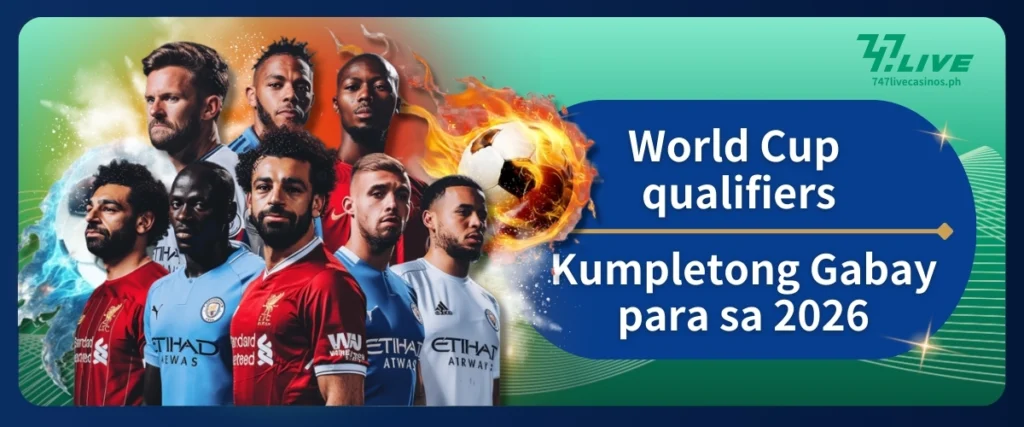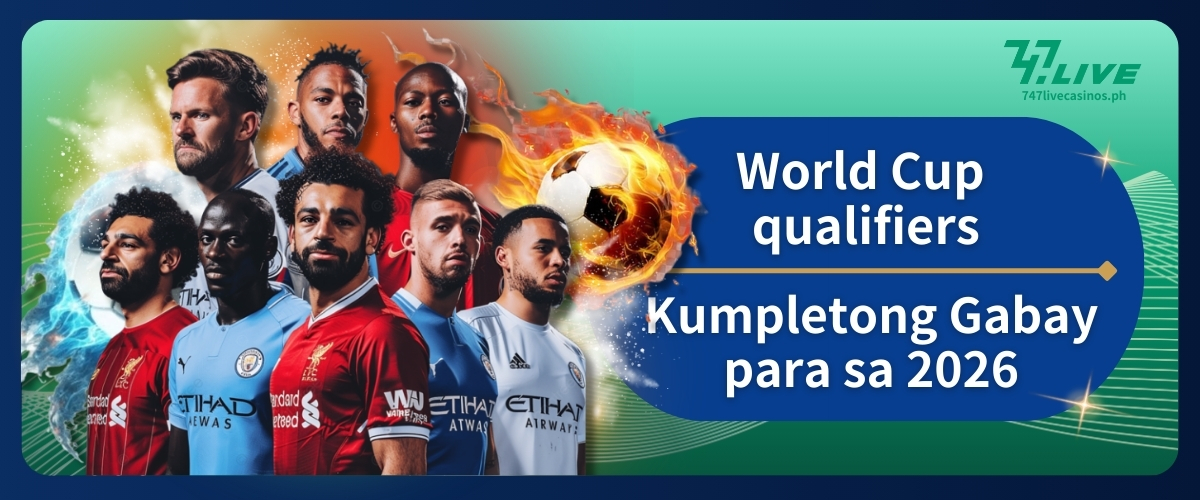
Ang World Cup qualifiers ay nagiging pinakamahalagang bahagi ng international football calendar, na nagbibigay ng opportunity sa mga bansa na makamit ang kanilang pangarap na makakuha ng slot sa FIFA World Cup. Ang qualification process para sa 2026 World Cup ay naging mas competitive at exciting dahil sa expansion ng tournament mula 32 patungo sa 48 teams, na nagdudulot ng mas maraming opportunities para sa mga aspiring football nations.
Para sa mga Pilipinong football enthusiasts at sports betting fans, ang World Cup qualifiers ay hindi lamang thrilling na sporting spectacle, kundi nagbubukas din ng maraming possibilities para sa entertainment at engagement sa iba’t ibang platforms na nag-o-offer ng sports-related gaming experiences.
Paano Gumagana ang World Cup qualifiers System
Ang World Cup qualifiers ay complex na process na nag-involve ng lahat ng FIFA confederations sa buong mundo. Ang bawat confederation ay may sariling qualification format at allocated slots para sa final tournament, na nag-ensure ng balanced global representation sa World Cup.
Ang current qualification cycle para sa 2026 World Cup ay particularly significant dahil ito ang first time na three countries – United States, Canada, at Mexico – ay magkakasamang mag-ho-host ng tournament. Ang unique hosting arrangement na ito ay nag-affect sa qualification structure, dahil ang tatlong host nations ay automatic qualified, na nag-reduce ng available slots para sa other CONCACAF nations. Para sa mga mahilig sa online entertainment platforms tulad ng 747 Live, ang extended qualification period ay nagbibigay ng mas maraming opportunities para sa sports betting at related gaming activities.
AFC Asian Qualifiers Structure
Ang Asian Football Confederation ay nag-implement ng five-round qualification system para sa 2026 World Cup qualifiers. Ang first round ay nag-feature ng 20 lowest-ranked Asian teams na nag-compete sa home-and-away basis. Ang mga winners ay nag-advance sa second round kasama ang 26 highest-ranked Asian nations.
Ang second round ay nag-involve ng 36 teams na divided sa nine groups of four teams each. Ang group winners at runners-up ay automatic qualified para sa 2027 AFC Asian Cup at nag-advance sa third round ng World Cup qualifiers. Ang third round ay considered na most crucial phase, dahil dito nagde-determine ang mga teams na makakakuha ng direct World Cup berths.
Ang fourth at fifth rounds ay nag-serve bilang additional qualifying opportunities para sa teams na hindi naka-qualify directly. Ang final Asian representative ay makakakuha ng slot sa inter-confederation playoffs, na mag-determine ng additional World Cup berths.
European Qualifying Campaign
Ang UEFA qualification para sa World Cup qualifiers ay traditionally naging most competitive region dahil sa high level ng football development sa Europe. Para sa 2026 World Cup, ang Europe ay allocated ng 16 direct qualifying slots, na pinakamarami sa lahat ng confederations.
Ang European World Cup qualifiers ay typically organized sa group stage format, na sunod ng playoffs para sa additional qualifying spots. Ang qualification matches ay usually nag-take place sa FIFA international windows, na nag-ensure ng consistent scheduling across all confederations.
CONCACAF Qualification Journey
Ang CONCACAF region ay nag-undergo ng significant changes sa kanilang World Cup qualifiers format dahil sa three automatic host nation berths. Ang remaining CONCACAF nations ay nag-compete para sa limited number ng available slots, na nag-intensify ng competition sa region.
Ang CONCACAF qualification ay nag-start sa preliminary rounds para sa lowest-ranked nations, na gradually nag-build up sa final hexagonal round na nag-feature ng strongest teams sa region. Ang sports betting enthusiasts ay particularly interested sa CONCACAF matches dahil sa unpredictable nature ng results at high-scoring games.
Central American Nations Performance
Ang Central American countries ay consistently nag-compete sa World Cup qualifiers, na nag-showcase ng improving football standards sa region. Nations tulad ng Costa Rica, Honduras, at Guatemala ay may rich World Cup qualifying history at dedicated fan bases na nag-support sa kanilang national teams.
Ang home advantage ay particularly important sa CONCACAF World Cup qualifiers, dahil sa varying climate conditions at altitude differences across venues. Ang teams ay nag-strategize specifically para sa away matches sa challenging environments, na nag-add ng tactical complexity sa qualification campaigns.
Caribbean Football Development
Ang Caribbean nations ay gradually nag-improve sa World Cup qualifiers participation, na nag-benefit sa increased investment sa grassroots football development. Ang smaller Caribbean islands ay nag-punch above their weight sa qualification matches, na nag-create ng inspiring underdog stories.
Ang Caribbean teams ay usually nag-face additional challenges sa World Cup qualifiers dahil sa limited resources at infrastructure, pero ang passion para sa football ay nag-drive sa kanilang competitive spirit sa international stage.
South American Qualifying Intensity
Ang CONMEBOL qualification para sa World Cup qualifiers ay kilala bilang most demanding qualification process sa mundo, dahil sa high level ng competition at compact tournament format. Ang South American teams ay nag-compete sa round-robin format na nag-feature ng all CONMEBOL nations, na nag-ensure ng consistent high-quality matches.
Ang traditional powerhouses tulad ng Brazil, Argentina, at Uruguay ay usually nag-qualify comfortably, pero ang competition para sa remaining spots ay extremely intense. Ang altitude factor sa venues tulad ng La Paz at Quito ay nag-add ng unique challenges para sa visiting teams sa World Cup qualifiers.
Emerging South American Nations
Ang countries tulad ng Ecuador, Colombia, at Peru ay nag-establish ng strong World Cup qualifying records sa recent cycles. Ang improvement ng football infrastructure at coaching standards ay nag-contribute sa increased competitiveness ng CONMEBOL World Cup qualifiers.
Ang fan support sa South America ay legendary, na nag-create ng incredible atmospheres during World Cup qualifiers matches. Ang passionate supporters ay nag-travel across continents para suportahan ang kanilang national teams sa crucial qualifying matches.
Traditional Rivalries Impact
Ang historic rivalries tulad ng Brazil vs Argentina at Chile vs Peru ay nag-add ng extra intensity sa World Cup qualifiers matches. Ang mga rivalry games ay often nag-determine ng momentum para sa entire qualification campaigns at nag-create ng memorable moments para sa football fans.
African Qualifying Challenges
Ang CAF qualification para sa World Cup qualifiers ay nag-involve ng largest number ng participating nations, na nag-create ng complex tournament structure. Ang African teams ay nag-compete sa multiple rounds, na nag-start sa preliminary phases at nag-culminate sa final group stages.
Ang logistical challenges sa Africa ay particularly demanding para sa World Cup qualifiers, dahil sa vast distances between countries at varying infrastructure levels. Ang teams ay often nag-face significant travel challenges na nag-affect sa preparation at performance sa crucial matches.
North African Dominance
Ang North African nations tulad ng Morocco, Egypt, at Tunisia ay traditionally strong performers sa World Cup qualifiers. Ang mga teams na ito ay may established football infrastructure at experienced coaching staff na nag-contribute sa consistent qualification success.
Ang North African teams ay nag-benefit sa strategic geographic location na nag-allow ng easier travel para sa European-based players. Ang dual-nationality players ay often nag-choose to represent North African nations sa World Cup qualifiers, na nag-strengthen ng team quality.
Sub-Saharan Africa Rising
Ang Sub-Saharan African nations ay increasingly competitive sa World Cup qualifiers, na nag-showcase ng developing football talent sa region. Countries tulad ng Nigeria, Ghana, at Senegal ay nag-produce ng world-class players na nag-compete sa top European leagues.
Ang youth development programs sa Sub-Saharan Africa ay gradually improving, na nag-create ng sustainable pipeline ng talent para sa future World Cup qualifiers campaigns. Ang investment sa coaching education ay nag-contribute sa tactical sophistication ng African teams.
Oceania Qualification Breakthrough
Ang OFC qualification para sa World Cup qualifiers ay historically challenging dahil sa limited allocated slots para sa region. Ang 2026 World Cup expansion ay nag-provide ng guaranteed berth para sa Oceania para sa first time sa World Cup history, na revolutionary development para sa region.
Ang Australia’s departure mula OFC patungo AFC ay nag-significantly change ng competitive landscape sa Oceania World Cup qualifiers. Ang New Zealand ay naging dominant force sa region, pero ang competition mula other Pacific nations ay gradually improving.
Pacific Island Football Growth
Ang Pacific Island nations ay nag-invest sa football development programs na nag-target sa long-term improvement sa World Cup qualifiers performance. Ang countries tulad ng Fiji, Vanuatu, at Solomon Islands ay nag-develop ng structured approaches sa player development at coaching education.
Ang geographic isolation ng Pacific Islands ay nag-create ng unique challenges para sa World Cup qualifiers preparation, dahil sa limited opportunities para sa high-level competition. Ang teams ay nag-rely sa occasional tournaments at friendly matches para sa international experience.
New Zealand’s Regional Leadership
Ang New Zealand ay nag-assume ng leadership role sa Oceania World Cup qualifiers, na nag-provide ng technical assistance at development programs para sa smaller Pacific nations. Ang All Whites ay consistently nag-represent ng region sa inter-confederation playoffs, na nag-showcase ng Oceania football standards.
Konklusyon
Ang World Cup qualifiers ay naging fundamental na bahagi ng global football landscape, na nag-provide ng pathway para sa national teams na ma-achieve ang kanilang ultimate goal ng World Cup participation. Ang qualification process ay continuously evolving para ma-accommodate ang changing dynamics ng international football at ma-ensure ng fair representation para sa all confederations.
Ang 2026 World Cup qualifiers ay particularly historic dahil sa expanded tournament format at three-nation hosting arrangement, na nag-create ng unprecedented opportunities para sa football development worldwide. Ang qualification journey ay hindi lamang about reaching ang World Cup, kundi about inspiring nations, developing football infrastructure, at creating lasting memories para sa players at fans alike.
Mga Madalas na Itanong Tungkol sa World Cup Qualification
Paano nag-determine ang FIFA ng slots para sa bawat confederation sa World Cup qualifiers?
Ang slot allocation para sa World Cup qualifiers ay base sa historical performance ng confederations sa previous World Cups, current FIFA rankings ng member nations, at overall football development sa each region. Ang FIFA Council ay nag-approve ng final slot distribution pagkatapos ng extensive analysis ng various factors na nag-affect sa global football landscape.
Ilan ang total matches na nilalaro sa buong World Cup qualifiers process?
Ang World Cup qualifiers ay nag-involve ng hundreds ng matches across all confederations, na nag-start mula preliminary rounds hanggang final qualifying playoffs. Ang exact number ay nag-vary depende sa confederation format, pero overall, mahigit 1,000 matches ay nilalaro worldwide para ma-determine ang final 48 World Cup participants.
May home advantage ba sa World Cup qualifiers matches?
Ang home advantage ay significantly important sa World Cup qualifiers, na nag-manifest sa higher win percentages para sa home teams across all confederations. Ang factors tulad ng crowd support, familiar playing conditions, reduced travel fatigue, at referee bias ay nag-contribute sa statistical advantage ng home teams sa qualifying matches.
Paano nag-affect ang expansion sa 48 teams sa qualification process ng 2026 World Cup?
Ang 2026 World Cup expansion sa 48 teams ay nag-significantly increase ng available qualification slots across all confederations, na nag-provide ng more opportunities para sa nations na historically nag-struggle sa World Cup qualifying. Ang expanded format ay nag-create ng more inclusive qualification process na nag-encourage ng football development sa emerging nations, habang nag-maintain ng competitive standards para sa final tournament.
Ano ang mga bagong features ng FIFA 2026 qualification process?
Ang FIFA 2026 qualification process ay nag-introduce ng inter-confederation playoffs na nag-provide ng additional pathways para sa World Cup berths. Ang new format ay nag-ensure na all confederations ay may guaranteed representation sa final tournament, na nag-promote ng global football development at increased competitive balance sa world stage.

